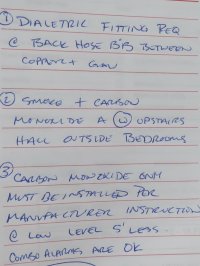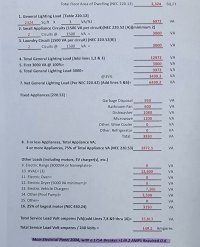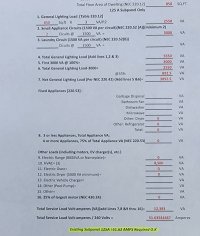-
Welcome to The Building Code Forum
Your premier resource for building code knowledge.
This forum remains free to the public thanks to the generous support of our Sawhorse Members and Corporate Sponsors. Their contributions help keep this community thriving and accessible.
Want enhanced access to expert discussions and exclusive features? Learn more about the benefits here.
Ready to upgrade? Log in and upgrade now.
You are using an out of date browser. It may not display this or other websites correctly.
You should upgrade or use an alternative browser.
You should upgrade or use an alternative browser.
An average day
- Thread starter ICE
- Start date
Well since we are discussing CO alarms here is a correction that states that the CO alarm shall not be more than five feet above the floor....it further states that combination alarms are permitted. That would place the smoke alarm five feet or less above the floor.
There is also a requirement for a dielectric union between a copper hose bibb and a galvanized pipe. There might be copper hose bibbs available but I have only seen brass hose bibbs. I don't recall having encountered dielectric unions for brass to iron anything.

There is also a requirement for a dielectric union between a copper hose bibb and a galvanized pipe. There might be copper hose bibbs available but I have only seen brass hose bibbs. I don't recall having encountered dielectric unions for brass to iron anything.

TheCommish
SAWHORSE
smoke and CO alarms should be installed in accordance it manufacture instructions not state law
Msradell
SAWHORSE
They need to be installed to meet whichever is the strictest between code and manufacturer instructions.smoke and CO alarms should be installed in accordance it manufacture instructions not state law
The inspector’s reference to state law was that state law requires alarms….not where to place the alarms. I created a handout that explained where the alarms should be placed. That handout was provided with every permit that was issued in the district office that I was assigned to. The alarms were still a pain in the ass but it might have been worse without the handout.
TheCommish
SAWHORSE
I disagree, the manufacture has had the device test by a recognized laboratory under a defined testing procedure and listed for their use, the manufactures listing always wins.They need to be installed to meet whichever is the strictest between code and manufacturer instructions.
mtlogcabin
SAWHORSE
No it does not and I challenge you to point to a code section that is specific to smoke detectors. You will find the manufactures installation requirement for other types of detectors but not smoke detectors for residential occupancies.the manufactures listing always wins.
fatboy
Administrator
[A] 102.1 General. Where there is a conflict between a generalI disagree, the manufacture has had the device test by a recognized laboratory under a defined testing procedure and listed for their use, the manufactures listing always wins.
requirement and a specific requirement, the specific
requirement shall be applicable. Where, in any specific case,
different sections of this code specify different materials,
methods of construction or other requirements, the most
restrictive shall govern.
The building code can require compliance with standards adopted by another organization as long as the requirement is specific as to what is required and is specific as to date of adoption of the standard.
Requiring that the product complies with the manufactures recommendations effectively delegates to the manufacturer the authority to modify the code, which is a law. This is not compatible with our system of laws.
I believe that this confusion arises because it is often required in contracts that the contractor comply with the manufacture's instructions. This is done so that if there are problems the building owner can sue the manufacturer if there are problems. Just because something is acceptable in the context of contracts does not mean that it is proper for the laws to require.
Building codes are laws and are required to be adopted by a legislative body. In some cases regulations, which are a subset of laws, can be adopted by administrative agencies when the legislative body has delegated to the administrative agency the right to adopt regulations if they have also specified limits on that agency. Both legislative bodies and legislative agencies are governmental entities but a manufacture is not and thus cannot adopt or modify the laws.
Requiring that the product complies with the manufactures recommendations effectively delegates to the manufacturer the authority to modify the code, which is a law. This is not compatible with our system of laws.
I believe that this confusion arises because it is often required in contracts that the contractor comply with the manufacture's instructions. This is done so that if there are problems the building owner can sue the manufacturer if there are problems. Just because something is acceptable in the context of contracts does not mean that it is proper for the laws to require.
Building codes are laws and are required to be adopted by a legislative body. In some cases regulations, which are a subset of laws, can be adopted by administrative agencies when the legislative body has delegated to the administrative agency the right to adopt regulations if they have also specified limits on that agency. Both legislative bodies and legislative agencies are governmental entities but a manufacture is not and thus cannot adopt or modify the laws.
I never understood how you could have a viable combination device. CO is slightly more dense than air and therefore will not rise of its own accord. Lacking air currents to carry the CO to the ceiling you'd be dead before the alarm went off. That having been said, ...No it does not and I challenge you to point to a code section that is specific to smoke detectors. You will find the manufactures installation requirement for other types of detectors but not smoke detectors for residential occupancies.
[RB] MANUFACTURER’S INSTALLATION INSTRUCTIONS. Printed instructions included with equipment as
part of the conditions of their listing and labeling.
If you violate the manufacturers' installation instructions you void the listing.
According to all that I can find on the internet, CO is not heavier than air and will disperse evenly in air. The alarm manufactures allow the alarms on walls as well as ceilings with restrictions from things that move air such as fans and HVAC registers,I never understood how you could have a viable combination device. CO is slightly more dense than air and therefore will not rise of its own accord. Lacking air currents to carry the CO to the ceiling you'd be dead before the alarm went off. That having been said, ...
[RB] MANUFACTURER’S INSTALLATION INSTRUCTIONS. Printed instructions included with equipment as
part of the conditions of their listing and labeling.
If you violate the manufacturers' installation instructions you void the listing.
Last edited:
TheCommish
SAWHORSE
I have seen text with the specific gravity of CO both slightly above and below 1, it freely mixes in are so the the high verses low mount is up to the manufacture, for the listing I have seen keep them out of the corner dead spots
TheCommish
SAWHORSE
let me work on thatNo it does not and I challenge you to point to a code section that is specific to smoke detectors. You will find the manufactures installation requirement for other types of detectors but not smoke detectors for residential occupancies.
steveray
SAWHORSE
R104.9 Approved materials and equipment. Materials,
equipment and devices approved by the building official shall
be constructed and installed in accordance with such
approval.
R106.1.2 Manufacturer’s installation instructions.
Manufacturer’s installation instructions, as required by
this code, shall be available on the job site at the time of
inspection.
equipment and devices approved by the building official shall
be constructed and installed in accordance with such
approval.
R106.1.2 Manufacturer’s installation instructions.
Manufacturer’s installation instructions, as required by
this code, shall be available on the job site at the time of
inspection.
steveray
SAWHORSE
102.8 in the IMC has stuff on listing vs. code...But I think that is the only place....
as part of the requirements of this code to the prescribed
extent of each such reference and as further regulated in Sections
102.8.1 and 102.8.2.
Exception: Where enforcement of a code provision would
violate the conditions of the listing of the equipment or
appliance, the conditions of the listing and the manufacturer’s
installation instructions shall apply.
[A] 102.8.1 Conflicts. Where conflicts occur
as part of the requirements of this code to the prescribed
extent of each such reference and as further regulated in Sections
102.8.1 and 102.8.2.
Exception: Where enforcement of a code provision would
violate the conditions of the listing of the equipment or
appliance, the conditions of the listing and the manufacturer’s
installation instructions shall apply.
[A] 102.8.1 Conflicts. Where conflicts occur
California:
The State Fire Marshal requires the installation of approved smoke alarms in all residential properties in California. All approved smoke alarms/detectors are listed by the State Fire Marshal to comply with California Health & Safety Code 13113.7.
Not sure about the Co2?
mtlogcabin
SAWHORSE
Manufactures instructions when required by the code IMC, IFGC and IPC typically reference the installation of equipment, appliances and testing of systems.
Think of Type I hood clearance reductions or testing PEX with air or how to seal ductwork. Unless the code specifically references the manufactures installation instructions they are not part of the code and thus not applicable.
Think of Type I hood clearance reductions or testing PEX with air or how to seal ductwork. Unless the code specifically references the manufactures installation instructions they are not part of the code and thus not applicable.
All of the codes require that the building official approve the use of any product, be it material or equipment. The codes state that a building official can rely on the listing and labeling by a recognized agency as proof that the equipment or material is safe for use. There is a caveat that the equipment or material shall be used in conformance with the listing.
Installation instructions are part of the listing. How could that not be true? I have challenged NRTL listings based on inadequate/inaccurate installation instructions and I have prevailed.
Installation instructions are part of the listing. How could that not be true? I have challenged NRTL listings based on inadequate/inaccurate installation instructions and I have prevailed.
The scope of work is installing solar and downsizing the service panel main breaker to 175 amps. The reason for downsizing the main breaker is toiaccommodate more solar amps than the 120% rule would allow with a 200 amp main. The inspector challenged the load calculation based on the fact that the pool, two AC units and the vehicle charger were omitted. This is the new load calculation.




Last edited:
mtlogcabin
SAWHORSE
ICE
Just curious
The general lighting load is based on 3 VA per sq ft. Is that using incandescent light bulbs or LED? Wouldn't LED's reduce that number quit a bit if the 3va per sq ft factor is based on incandescent light bulbs.
Just curious
The general lighting load is based on 3 VA per sq ft. Is that using incandescent light bulbs or LED? Wouldn't LED's reduce that number quit a bit if the 3va per sq ft factor is based on incandescent light bulbs.
I do not have an answer to your question. The following code might shed some light on the issue of lights in that the lights are just a part of the 3 VA.ICE
Just curious
The general lighting load is based on 3 VA per sq ft. Is that using incandescent light bulbs or LED? Wouldn't LED's reduce that number quit a bit if the 3va per sq ft factor is based on incandescent light bulbs.
Dwelling Occupancies. In one-family, two-family, and multifamily dwellings and in guest rooms or guest suites of hotels and motels, the outlets specified in (J)(1), (J)(2), and (J)(3) are included in the general lighting load calculations of 220.12. No additional load calculations shall be required for such outlets.
(1) All general-use receptacle outlets of 20-ampere rating or less, including receptacles connected to the circuits in 210.11(C)(3)
(2) The receptacle outlets specified in 210.52(E) and (G)
(3) The lighting outlets specified in 210.70(A) and (B)
Paul Sweet
SAWHORSE
This works for now in California, but a lot of homes are going to require service upgrades once you're forced to switch from gas to electricity for heat, water heater, dryer, range, etc.
I've always used the optional calculation of NEC 220.82.
The NEC still requires using 3 watts/SF for lighting & receptacles for calculations.
I've always used the optional calculation of NEC 220.82.
The NEC still requires using 3 watts/SF for lighting & receptacles for calculations.
